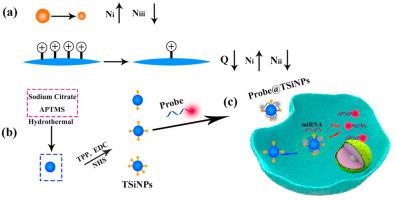Talanta ( IF 5.6 ) Pub Date : 2021-01-15 , DOI: 10.1016/j.talanta.2021.122114 Chunrong Li , Yanfei Zhang , Jun Chen , Liping Liu , Huihui Yang , Si-Yang Liu , Yuzhi Xu , Zong Dai , Xiaoyong Zou

|
Nanomaterial-based on-off-on fluorescence sensing strategies are significant particularly in intracellular nucleic acids imaging assay. There still remains challenge to rationally balance fluorescence quenching efficiency and recovery dynamics. We assume that the performance of on-off-on fluorescence sensing strategy can be fundamentally improved on small zero-dimensional (0D) nanomaterial with precisely modulated surface charge. For a proof-of-concept demonstration, silicon nanoparticle (SiNP) with ~4 nm was synthesized and used as the quencher model, of which the surface charge density was modulated by modification of triphenylphosphonium (TPP). The influence of particle size, surface charge and charge density of the nanomaterials on sensing performance was systematically investigated. The strategy showed a low limit of detection (LOD) as 26 pM for target model miR-494, which is one of the lowest in nanomaterial-based on-off-on sensing platforms. And the LOD is even comparable to amplification-based methods in a greatly shortened assay time (2.5 h). The miR-494 expresses in cancerous and normal living cells of human cervical carcinoma (HeLa), human lung carcinoma (A549), human breast cancer (MCF-7), and normal human mammary epithelial (MCF-10A) cells were imaged and localized with significantly improved sensitivity and specificity. These excellent performances insure it a promising candidate as convenient and non-enzymatic sensing platform for miRNA-associated disease detection and early diagnosis.
中文翻译:

带有小且可调节电荷的纳米颗粒的荧光开关,可在活细胞中进行高度灵敏的细胞内microRNA成像
基于纳米材料的开关荧光传感策略尤其重要,特别是在细胞内核酸成像分析中。合理地平衡荧光猝灭效率和恢复动力学仍然存在挑战。我们假设在具有精确调制的表面电荷的小型零维(0D)纳米材料上,可以从根本上改善开关荧光传感策略的性能。为了进行概念验证,合成了〜4 nm的硅纳米粒子(SiNP)并将其用作淬灭剂模型,其表面电荷密度通过修饰三苯基phosph(TPP)进行调节。系统地研究了纳米材料的粒径,表面电荷和电荷密度对传感性能的影响。该策略显示目标模型miR-494的检测下限(LOD)为26 pM,这是基于纳米材料的开关式传感平台中最低的检测限之一。LOD在大大缩短的检测时间(2.5小时)中甚至可以与基于扩增的方法相媲美。miR-494在人宫颈癌(HeLa),人肺癌(A549),人乳腺癌(MCF-7)和正常人乳腺上皮(MCF-10A)细胞的癌细胞和正常活细胞中表达并进行成像和定位大大提高了灵敏度和特异性。这些出色的性能确保它有望成为miRNA相关疾病检测和早期诊断的便捷且非酶促的传感平台。LOD在大大缩短的检测时间(2.5小时)中甚至可以与基于扩增的方法相媲美。miR-494在人宫颈癌(HeLa),人肺癌(A549),人乳腺癌(MCF-7)和正常人乳腺上皮(MCF-10A)细胞的癌细胞和正常活细胞中表达并进行成像和定位大大提高了灵敏度和特异性。这些出色的性能确保它有望成为miRNA相关疾病检测和早期诊断的便捷且非酶促的传感平台。LOD在大大缩短的检测时间(2.5小时)中甚至可以与基于扩增的方法相媲美。miR-494在人宫颈癌(HeLa),人肺癌(A549),人乳腺癌(MCF-7)和正常人乳腺上皮(MCF-10A)细胞的癌细胞和正常活细胞中表达大大提高了灵敏度和特异性。这些出色的性能确保它有望成为miRNA相关疾病检测和早期诊断的便捷且非酶促的传感平台。对正常人乳腺上皮(MCF-10A)细胞进行成像和定位,从而显着提高了灵敏度和特异性。这些出色的性能确保它有望成为miRNA相关疾病检测和早期诊断的便捷且非酶促的传感平台。对正常人乳腺上皮(MCF-10A)细胞进行成像和定位,从而显着提高了灵敏度和特异性。这些出色的性能确保它有望成为miRNA相关疾病检测和早期诊断的便捷且非酶促的传感平台。











































 京公网安备 11010802027423号
京公网安备 11010802027423号